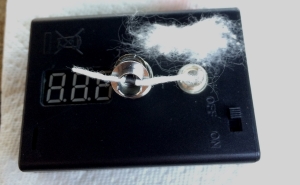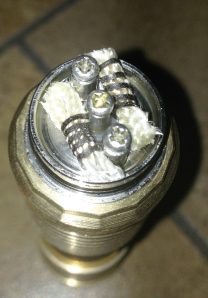When I initially set out to write this post, I had intended on building a basic coil on an IGO-L, but figured that while I was at it, I’d rebuild a ProTank atomizer or two with cotton wicks for my On The Go Kit. While doing that, I was on the phone with a friend, and we got to talking about the number of tanks that use a ProTank atomizer. I figured I’d be doing all of the people using those a disservice if I didn’t make a post that covers how to rebuild one. As a bonus, this particular build is both fairly easy (though as depicted does require some special tools, which you should have anyway), and produces one of the best Vapes that I’ve ever had. So, let’s build!
I’m using 30g Kanthal A1 (because I want a coil that is between 1.7 and 2.4 ohms), CVS sterile rolled cotton, an original ProTank, an 18g blunt tip syringe, and a generic ohm meter (if you don’t have one of these, I highly recommend picking one up, they are rather inexpensive, like $20, and very convenient). Not shown is a butane torch (I don’t know why I left that out of the photo).
Pull the atomizer apart (pop the chimney off, and then remove the positive pin, and everything should just pull apart), and discard the old coil/wicks. Rinse and clean the parts that you are keeping in preparation for the new build (I usually just wipe them down real good).
Nothing terribly over complicated here. First torch the kanthal until it glows to both clean it, and to remove some of the springiness to make wrapping easier. I start with a 6-8″ piece of wire. You can always cut it shorter, it’s real hard to get it longer once cut. I leave 1.5-2″ legs at this stage (better too long than too short), and just wrap around the 18g blunt tip needle between 8 and 12 times depending on the resistance I want to end up with.
You can see here that I’ve done a 9/8 wrap. This should get me between 1.7 and 1.8ohms on the final coil. Next you want to compress the coil at one end and hold it there for a few seconds. This makes it much easier to get it compressed in the pliers later.
Now we need to torch the coil to get it to retain its shape. Slide it off of the needle, and carefully grip it in some pliers. I hold the hottest part of the torch flame on the coil for a solid ten seconds once I get it in the pliers straight:
Here is where this pays off, put the coil back onto the needle, and mount it into the atomizer base, as shown below:
This makes mounting coils on these atomizers a cinch. The needle is thin enough that it places the coil at the bottom of the channel in the sides of the atomizer base. This is the perfect position. Get the coil centered and put the insulator ring and positive pin back in place (remember that one leg of the coil goes inside the insulator ring, and the other goes between the insulator ring and the atomizer base).
As you can see from the image above, I don’t push the positive pin all the way in. I leave it sticking out enough that it can be seated correctly once the atomizer is installed in the tank base. At this point I will twist off the excess coil leg lengths, so that the they are flush with the base. You can clip them off, but I find that a little spin and wiggle will break them off more cleanly. Make sure the coil is centered in the split, and not touching the sides of the atomizer base, and remove the needle.
Let’s test it out real quick:
Now we need wick! Here is how much cotton I will need (this is actually a bit more than I’ll need):
You can see that it doesn’t take much at all. I’ll tell you now, you should go wash your hands with a non scented soap. I use sterile cotton and I can taste the difference in my wicks when I do wash my hands at this point and when I don’t. Once you are ready, tear about half of that cotton off lengthwise, and roll it into a wick shape that will fit inside the coil you mounted. You don’t need terribly much cotton here.
Again you can see that it doesn’t take much. Once you have the wick twisted, you just slide it into the coil. I find it helpful to clip off the very tip of the wick, and spin it as you insert it, so that it slides in easier. Once mounted, clip both sides off flush with the outside edge of the atomizer base like so:
I then use the rest of the cotton as a “flavor” wick. This does a couple of things; it keeps the coil wetter, it prevents hot juice popping into your mouth, and creates a better seal in the tank. I make the wick tails long on purpose, like so:
Now we need to prime the wicks. Cotton’s one drawback is that it burns rather easily. make sure you get it wet, and keep it wet. Burned cotton is nasty.
Reassemble the atomizer, and tuck the wick tails into the atomizer base.
Make sure that your top wick is not too dense, as you want juice to easily flow through it, but it should provide some barrier to juice just pouring into the atomizer. Let’s test it one more time and fill her up!
Now we can fill and prime the atomizer. Once the tank is full you need to either let it sit for about five minutes, or give it a few long draws to get all the air out of the wicks and ensure they are saturated with juice.
That’s it, this should now be ready to vape.
I personally think that this is the apex build for ProTank atomizers. It is flavorful, and easy enough to build.

































